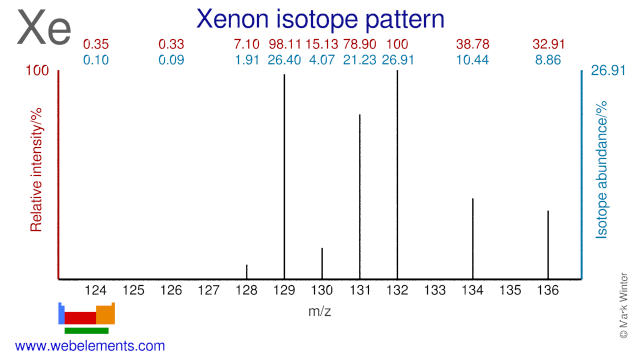Xenon - 54Xe: the essentials
- Name: xenon
- Symbol: Xe
- Atomic number: 54
- Relative atomic mass (Ar): 131.293 (6) g,m [see note g
- Standard state: gas at 298 K
- Appearance: colourless
- Classification: Non-metallic
- Group in periodic table: 18
- Group name: Noble gas
- Period in periodic table: 5
- Block in periodic table: p
- Shell structure: 2.8.18.18.8
- CAS Registry: 7440-63-3
Xenon atoms have 54 electrons and the shell structure is 2.8.18.18.8. The ground state electronic configuration of neutral xenon is [Kr].4d10.5s2.5p6 and the term symbol of xenon is 1S0.
Xenon: description
Xenon is a "noble" or "inert" gas present in the atmosphere to a small extent. Xenon is present in the Martian atmosphere to the extent of about 0.08 ppm. Before 1962, it was generally assumed that xenon and other noble gases were unable to form compounds. Among the compounds of xenon now reported are xenon hydrate, sodium perxenate, xenon deuterate, difluoride, tetrafluoride, hexafluoride, and XePtF6 and XeRhF6. The highly explosive xenon trioxide, XeO3, is known.
Metallic xenon is produced by applying several hundred kilobars of pressure. Xenon in a vacuum tube produces a blue glow when excited by an electrical discharge and finds use in strobe lamps. It is an odourless, colourless, inert gas.

Image adapted with permission from Prof James Marshall's (U. North Texas, USA) Walking Tour of the elements CD.
Xenon: physical properties
Density of solid: 3640 kg m-3
Molar volume: 35.92 cm3
Thermal conductivity: 0.00569 (gas) W m‑1 K‑1
Xenon: heat properties
Melting point: 161.4 [‑111.7 °C (‑169.1 °F)] K
Boiling point: 165.1 [‑108 °C (‑162 °F)] K
Enthalpy of fusion: 20.5 kJ mol-1
Xenon: atom sizes
Atomic radius (empirical): (no data) pm
Molecular single bond covalent radius: 131 (coordination number 1,2) ppm
van der Waals radius: 206 ppm
Xenon: electronegativities
Pauling electronegativity: 2.6 (Pauling units)
Allred Rochow electronegativity: 2.40 (Pauling units)
Mulliken-Jaffe electronegativity: 2.73 (12.5% s orbital)
Xenon: orbital properties
First ionisation energy: 1170.35 kJ mol‑1
Second ionisation energy: 2023.8 kJ mol‑1
Third ionisation energy: 2996 kJ mol‑1
Xenon: abundances
Universe: 10 ppb by weight
Crustal rocks: 0.020 ppb by weight
Human: (no data) ppb by weight
Xenon: crystal structure

Xenon: biological data
Human abundance by weight: (no data) ppb by weight
Xenon has no biological role.
Xenon: uses
Xenon: reactions
Reactions of xenon as the element with air, water, halogens, acids, and bases where known.
Xenon: binary compounds
Binary compounds with halogens (known as halides), oxygen (known as oxides), hydrogen (known as hydrides), and other compounds of xenon where known.
Xenon: compound properties
Bond strengths; lattice energies of xenon halides, hydrides, oxides (where known); and reduction potentials where known.
Xenon: history
Xenon was discovered by Sir William Ramsay, Morris W. Travers in 1898 at England. Origin of name: from the Greek word "xenos" meaning "stranger".Xenon: isotopes

Of the nine stable Xenon isotopes, several are used in various medical and scientific applications. Xe-124 is used in the production of two radioisotopes: I-123 and I-125. I-123 is used extensively in diagnostic procedures while I-125 is used in the treatment of prostate cancer. Hyperpolarized Xe-129 is used in the magnetic resonance imaging of gas flows in the lungs. Xe-136 has been proposed as a detector for neutrinoless double Beta decay research. Xe-126 can be used as a target for the production of radioactive Ba-128.
Xenon: isolation
Isolation: xenon is present to a small extent in the atmosphere (less than 1 ppm by volume) and is obtained as a byproduct from the liquefaction and separation of air. This would not normally be carried out in the laboratory and xenon is available commercially in cylinders at high pressure.
